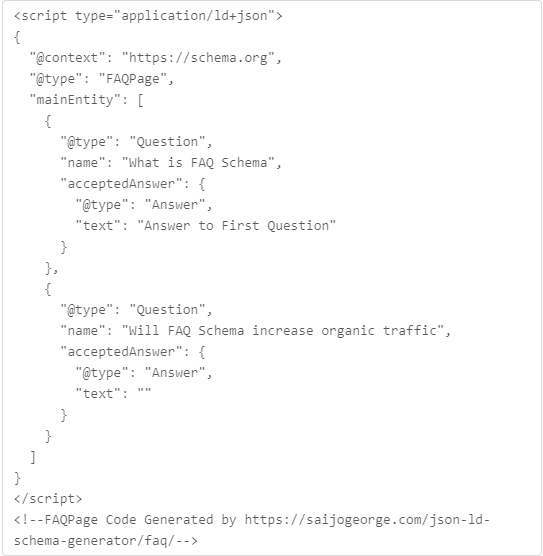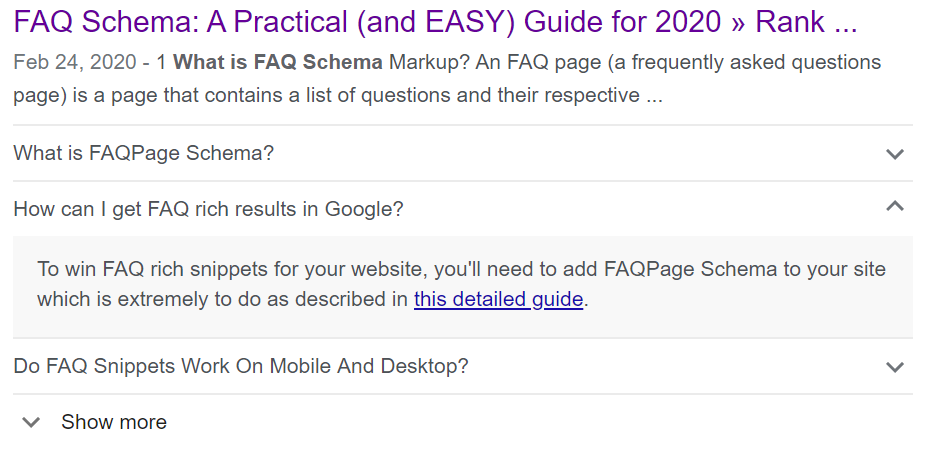FAQ Schema was a big topic when Google introduced it in late 2019. It provides webmasters an easy way to push organic traffic using the FAQ featured snippet using content from FAQ pages on the site.
Implementing it in the wrong way can be detrimental and do more harm than good to your organic traffic. Read on our easy tips and tricks on how to get the most benefit from the FAQ Schema.
FAQPage Schema
FAQPage Schema is a machine-readable markup that you add to the page. This markup is based on JSON-LD, aimed mainly to provide a representation of link data using JSON. It allows Google and other search engines to easily parse a page and extract a list of questions and answers on a particular topic.

Google will then use this information to produce a Feature Snippet in the SERP results, providing the user with a list of questions and answers in an accordion widget.

How to implement FaqPage Schema ?
You can add the FaqPage Schema by following the documentation from the schema.org documentation.
If you are not proficient with coding, you can opt to use an online tool like the one written by Saij George. It auto-generates the Json-ID for you by entering the list of questions and answers. You will then need to add the JSON-ID as part of the page html.
If you don’t want to manually modify the html and use WordPress, you can opt to install a plugin.
These plugins will add a widget that will show the questions and answers on the page and auto-generate the Schema and add to the page. As for all plugins you add to WordPress, make sure to add a plugin that has good reviews and has a large number of downloads, and is maintained by the developer.
One of the best plugins is Yoast. It is ideal to use it as you probably already have it installed on WordPress to help you with on-page SEO.
Testing the FAQ Schema
Make sure that you test and validate that the FAQ schema is properly set on the page.

The best tool for the job is the Rich Results Test Tool provided by Google. You can validate the code or paste the URL of the page that provides you with the results. You can also see how Google will render the FAQ schema on the SERP results.
How to use FAQPage Schema to increase your Organic Traffic?
The FAQ schema will give you the benefit of getting more estate on the SERP results. You target the user with different competitive keywords without the need to rank for them
FAQ feature snippet is a good way to provide an off-site user experience.
but …
If you satisfy the user question, the user will not access the internal pages.
Adding FAQ schema to your FAQ pages will translate in a reduction of organic traffic if your FAQ pages are ranking. Possibly impacting the conversion rates of your website.
To increase traffic from FAQPage schema is to change the way you provide the answer to the user.
The best approach is to provide an answer that satisfies the user, but you entice the user to read more by providing a link to an internal page.

The FAQPage Schema allows the inclusion of links to internal and external pages. It is important to note that the link has to point to another internal page, and the link has to be present on the page providing the answer. This is due to a restriction from Google that the text provided in the FAQPage Schema has to match the actual answer on the page. In the next section, we will cover all the Google guidelines.
Don’t abuse the FAQPage Schema
Google has some strict guidelines on how you can use the FAQPage Schema:
- It can be applied to any page with a list of questions with answers.
- The user cannot submit alternative answers. When you have such a layout, you should opt for a Q&A schema.
- You cannot use user FAQPage for advertisement.
- The text in the FAQPage has to match the text on the visible page.
- If the same question is present on multiple pages, you should use the markup on only one page.
Monitoring
It is important that you monitor the links you include in answers, so you understand the impact on introducing FAQPage Schema to your pages.
It will be hard to differentiate between traffic from organic from page ranking to traffic from an FAQ snippet. The best way to monitor traffic is to use Google Analytics UTM. You can set the utm_source to “google” utm_medium to “organic” and utm_campaign to an identifier to a particular answer on a FAQ feature snippet.
Using this approach, you can easily identify clicks coming from featured snippets and clicks coming from other pages.
Final Thoughts and Recommendations
FAQPage Schema can offer the benefit that can increase the real estate on search results. However, it has to be used with caution, and you need to do your homework on how you will present the answer to the user. If you are providing good off-page experience and exposure to your brand. Adding FAQPage scheme can reduce organic traffic to your pages.

Gain Changer co-founder Sean Bianco is well-versed in determining market trends. Emphasis is placed on understanding relationships between technical problems and customer impact, resulting in customer-driven products and services.

